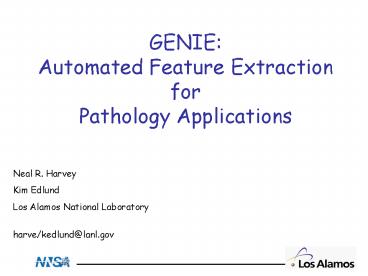GENIE: Automated Feature Extraction for Pathology Applications PowerPoint PPT Presentation
Title: GENIE: Automated Feature Extraction for Pathology Applications
1
GENIE Automated Feature Extraction for
Pathology Applications
Neal R. Harvey Kim Edlund Los Alamos National
Laboratory harve/kedlund_at_lanl.gov
2
Acknowledgements
- We should like to thank the following for
providing their medical expertise, data and some
results shown during this presentation - Dr. Richard Levenson, CRI inc.
- Dr. David Rimm, Yale University
- Dr. Carola Zalles, Yale University
- Dr. Cesar Angeletti (formerly of Yale University)
3
So much Data, So Little Information
- Satellite-based and other instrumentation today
produces unprecedented quantities of raw image
and signal data. - Hidden in this data is information of interest to
analysts and scientists. - How can this information be extracted
- Easily
- Rapidly
- Reliably
4
So much Data, So Little Information
- Microscope cameras, slide scanners and other
instrumentation today produces unprecedented
quantities of raw image data. - Hidden in this data is information of interest to
pathologists, other medics and scientists. - How can this information be extracted
- Easily
- Rapidly
- Reliably
5
Traditional Approach
Physical Modeling
6
GENIE Machine Learning
Easier to show a machine what to find ...than
to tell a machine how to find it GENIE
automatically generates an algorithm for future
use
Exploit
Train
7
Evolving Solutions
- GENIE is an Adaptive System
- It derives a general purpose image classifier
from a limited set of user-supplied examples. - It uses a hybrid genetic algorithm, combining
evolutionary exploration with statistical machine
learning.
8
Issues in Pixel Classification
- Spectral information often inadequate.
- Need to make use of textural and spatial context
cues. - Many, many ways of describing/encoding such
spatial context information. - Best techniques are task-specific.
- How do we do learn to map pixels to categories in
general?
9
The GENIE Approach
- Give GENIE a large and flexible toolbox of
image processing algorithms. - Use an evolutionary algorithm to explore which
tools are most appropriate for the current task. - Use statistical machine learning to learn how to
combine those tools together to give an accurate
classification.
10
GENIE Development
- 1999 Initial funding from two NRO DIIs
- Continued research funding from LANL, DOE and
others - 2002 RD 100 Award
- 2003 Transition to NGA funding for operational
version Genie Pro. - 2004 Genie Pro wins NGA Feature Extraction
Evaluation (bake-off)
11
GENIE and Pathology?
- Initial experiments in applying GENIE to
bio-medical data - Apply GENIE as is on multi-spectral pathology
data - i.e. make no modifications to/customization of
GENIE for the pathology field
12
(No Transcript)
13
GENIE and Colon Cancer Detection
14
GENIE and colon cancer detection (Training)
True color image Colon containing cancer and
normal tissue
True color image Colon containing only normal
tissue
Training data Green cancerous nuclei Red
everything else (i.e. not cancerous nuclei)
Training data Green none because no cancerous
nuclei Red everything else (i.e. not cancerous
nuclei)
15
GENIE and colon cancer detection (Exploitation)
16
GENIE Breast Cancer Detection (cancerous nuclei)
- Training Data
Training Data Cancer
Training Data Normal
17
GENIE Breast Cancer Detection (Cancerous Nuclei)
Results for training Data
Classification Results Cancer
Classification Results Normal
18
GENIE Breast Cancer Detection (Cancerous Nuclei)
Results for testing data (cancer)
19
GENIE Breast Cancer Detection (Cancerous Nuclei)
Results for testing data (normal)
20
GENIE and endometrial gland detection (training
data)
21
GENIE endometrium gland detection exploitation
over training data
22
GENIE endometrium gland detection exploitation
over testing data
23
GENIE and kidney inflammation detection (training)
True color image
Training result Greeninflammation Red
everything else
Training data Green inflammation Red
everything else
24
GENIE and kidney inflammation detection (testing)
True color image
Testing result Greeninflammation Red everything
else
25
GENIE and Other Bio-Medical Applications
- Vibrational Hyperspectral Imaging
- Fluorescence imaging
- FTIR (Fourier Transform Infra Red) imaging
- Raman spectroscopy
- CARS (Coherent Anti-Stokes Raman Scattering)
- Can exploit specific molecular signatures in
vibrational spectrum
26
GENIE application to VHI
Training data provided to GENIE
GENIE classification result
27
GENIE Urine Cytology Classification
28
GENIE Results Cover of Laboratory Investigation
When tested on urothelial cytology specimens
collected at two separate institutions over a
span of 4 years, GENIE showed a combined
sensitivity and specificity of 85 and 95,
respectively. Of particular note is that when
training was performed on cases initially
diagnosed as equivocal on cytology but with
follow-up biopsy, surgical specimen or cytology,
which was unequivocally benign or malignant,
GENIE was superior to the cytopathologist
interpreting the initial equivocal cytology
specimen.
29
Genie Pro Commercialization
Genie Pro has been exclusively licensed to
Aperio For all digital pathology applications

